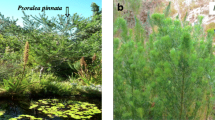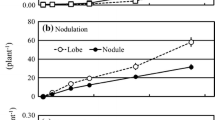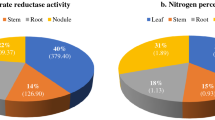Abstract
Morphology, biomass, nitrate reductase (NR) and nitrogenase activity in Albizia chinensis (Osb.) Merr. nodules were assessed on monthly and seasonal basis for 1 year. Average NR and nitrogenase activity was higher during the rainy season, reaching a maximum in August. Thereafter, activity decreased through autumn and reached a minimum value during winter. Fresh and dry biomass of nodules increased gradually from summer to the rainy season and then started decreasing with the onset of winter as nodules began to senesce. Among four developmental stages of the nodules that correspond to their increasing age, NR and nitrogenase activity remained low in stage 1 nodules and peaked in stage 2. The activity of both enzymes further decreased with increasing age (stage 2 to stage 4). Morphological features such as shape, diameter and color varied considerably among the developmental stages. Stage 1 nodules were cream-colored, oval to heart-shaped with smallest average diameter whereas at stage 2, they became bilobed to tetralobed. On the other hand, stage 3 nodules had the largest average diameter and were multilobed in structure. Stage 4 nodules that correspond to the senescing stage were dark brown to black, multilobed, flattened and hollow due to degeneration of nodular tissue.



Similar content being viewed by others
References
Aryal UK, Hossain MK, Mridha MAU, Xu HL (2000) Nodulation status and nitrogenase activity of some legume tree species in Bangladesh. J Crop Prod 3:325–335
Bethlenfalvay GJ, Phillips DA (1977) Ontogenetic interactions between photosynthesis and symbiotic nitrogen fixation in legumes. Plant Physiol 60:419–421
Chaukiyal SP (2007) Nitrogen fixation and nodule characteristics in Pongamia pinnata seedlings. Improvement and culture of nitrogen fixing trees, NFT News. Int Union For Res Organ 10(1):7–9
Chaukiyal SP, Mir RA, Pokhriyal TC (2013) Effect of nitrogen fertilizer on biomass production and nodulation behavior of Pongamia pinnata Pierre seedlings under nursery conditions. J For Res 24(3):531–538
Chaukiyal SP, Khatri N, Bhatia P, Kannojia P (2014) Nodulation and nitrogen fixation behavior study in the Myrica esculenta Buch.-ham. Ex D. Don trees under two different environmental conditions. Indian For 140(9):882–886
Cheng Q (2008) Perspectives in biological nitrogen fixation research. J Integr Plant Biol 50(7):784–796
Crawford NM, Kahn ML, Leustek T, Long SR (2000) Nitrogen and sulfur. In: Buchanan B, Gruissem W, Jones RL (eds) Biochemistry and molecular biology of plants. American Society of Plant Physiologists, Rockville, pp 786–849
Dart PJ, Mercer FV (1965) The effect of growth temperature, level of ammonium nitrate and light intensity on the growth and nodulation of cowpea (Vigna sinensis endl. ex hassk.). Aust J Agric Res 16(3):321–345
Evans HJ, Nason A (1953) Pyridine nucleotide nitrate reductase from extracts of higher plants. Plant Physiol 28:233–254
Galloway JN, Dentener J, Capone DG, Boyer EW, Howarth RW, Seitzinger SP, Asner GP, Cleveland CC, Green PA, Holland EA, Karl DM, Michaels AF, Porter JH, Townsend AR, Voosmarty CJ (2004) Nitrogen cycles: past, present, and future. Biogeochemistry 70(2):153–226
Gibson AH (1971) Factors in the physical and biological environment affecting nodulation and nitrogen fixation by legumes. Plant Soil 35(1):139–152
Gunther C, Schlereth A, Udvardi M, Ott T (2007) Metabolism of reactive oxygen species is attenuated in leghemoglobin-deficient nodules of Lotus japonicus. Mol Plant-Microbe Interact J 20(12):1596–1603
Hardy RWF, Holsten RD, Jackson EK, Burns RC (1968) The acetylene—ethylene assay for N2 fixation: laboratory and field evaluation. Plant Physiol 43:1185–1207
Hirsch AM (1992) Developmental biology of legume nodulation, Tansley Review No. 40. New Phytol 122:211–237
Hossain MS, Hossain MK, Koirala B (2001) Growth and nodulation status of seven multipurpose tree legumes grown in hill soils under nursery conditions. J For Environ 1:97–101
Huber HC, Bachmann M, Huber JL (1996) Post-translational regulation of NRA: a role for Ca2+ and 14 +3−3 proteins. Trends Plant Sci 1(12):432–438
Hungria M, Franco AA (1993) Effect of high temperature on nodulation and nitrogen fixation by Phaseolus vulgaris L. Plant Soil 149:95–102
Hungria M, Vargas MAT (2000) Environmental factors affecting N2 fixation in grain legumes in the tropics, with an emphasis on Brazil. Field Crops Res 65:151–164
Klepper L, Flesher D, Hageman RH (1971) Generation of reduced nicotenamide adenine dinucleotide for nitrate reduction in green leaves. Plant Physiol 48:580–590
Li XZ, Oaks A (1995) The effect of light on the nitrate and nitrite reductases in Zea mays. Plant Sci 109(2):115–118
Lohman KN, Gan S, John MC, Amasino RM (1994) Molecular analysis of natural leaf senescence in Arabidopsis thaliana. Physiol Plant 92:322–328
Lucinski R, Polcyn W, Ratajczak L (2002) Nitrate reduction and nitrogen fixation in symbiotic association Rhizobium-legumes. Acta Biochim Pol 49(2):537–546
Montanez A, Danso SKA, Hardarson G (1995) The effect of temperature on nodulation and nitrogen fixation by five Bradyrhizobium japonicum strains. Appl Soil Ecol 2(3):165–174
Pladys D, Vance PC (1993) Proteolysis during development and senescence of effective and plant gene-controlled ineffective alf-alfa nodules. Plant Physiol 103:379–384
Pokhriyal TC, Chaukiyal SP, Negi DS (1991) Seasonal changes in nodular nitrogenase and nitrate reductase activity in Dalbergia sissoo. Indian J Plant Physiol 34:166–170
Pokhriyal TC, Chaukiyal SP, Singh U (2001) Eucalyptus-Acacia mixed planting effects on nodular nitrogenase and nitrate reductase activity in Acacia nilotica seedlings. J Trop For Sci 13(2):290–296
Puppo A, Groten K, Bastian F, Carzaniga R, Soussi M, Lucas MM, de Felipe MR, Harrison J, Vanacker H, Foyer CH (2005) Legume nodule senescence: roles for redox and hormone signalling in the orchestration of the natural aging process. New Phytol 165(3):683–701
Roponen I (1970) The effect of darkness on the leghemoglobin content and amino acid levels in the root nodules of pea plants. Physiol Plant 23:452–460
Serraj R, Adu-Gyamfi J (2004) Role of symbiotic nitrogen fixation in the improvement of legume productivity under stressed environments. West Afr J Appl Ecol 6:95–109
Serraj R, Vadez V, Purcell LC, Sinclair TR (1999) Recent advances in the physiology of drought stress effects on symbiotic N2 fixation in soybean. In: Marto Anez E, Herna Andez G (eds) Highlights of nitrogen fixation research. Kluwer, New York, pp 49–55
Sharma E, Ambast RS (1984) Seasonal variation in nitrogen fixation by different ages of root nodules of Alnus nepalensis plantations in the Eastern Himalayas. J Appl Ecol 21:265–270
Van de Velde W, Guerra JC, De Keyser A, De Rycke R, Rombauts S, Maunoury N, Mergaert P, Kondorosi E, Holsters M, Goormachtig S (2006) Aging in legume symbiosis A molecular view on nodule senescence in Medicago truncatula. Plant Physiol 141(2):711–720
Witty JF, Minchin FR (1988) Measurement of nitrogen fixation by acetylene reduction assay: myths and mysteries. In: Beck DP, Materon LA (eds) Nitrogen fixation by legumes in mediterranean agriculture. Martinus Nijhoff Publisher, Dordrecht, pp 331–344
Acknowledgements
The present study was conducted in the Plant Physiology Discipline, Forest Research Institute (FRI), Dehradun, India. We are grateful to Dr. T.C. Pokhriyal, (retired), Botany Division, FRI, Dehradun for his guidance. We also thank the two anonymous reviewers for valuable suggestions that helped to improve the manuscript.
Author information
Authors and Affiliations
Contributions
VK performed the experiments, analyzed the data and wrote the manuscript; SPC designed the study, helped interpret results and improved the manuscript.
Corresponding author
Ethics declarations
Conflict of interest
Authors declare that they have no conflict of interest.
Additional information
The online version is available at http://www.springerlink.com
Corresponding editor: Zhu Hong.
Rights and permissions
About this article
Cite this article
Kushawaha, V., Chaukiyal, S.P. Nodule study in Albizia chinensis in relation to nitrogen metabolism, morphology and biomass. J. For. Res. 31, 57–63 (2020). https://doi.org/10.1007/s11676-018-0859-3
Received:
Accepted:
Published:
Issue Date:
DOI: https://doi.org/10.1007/s11676-018-0859-3




